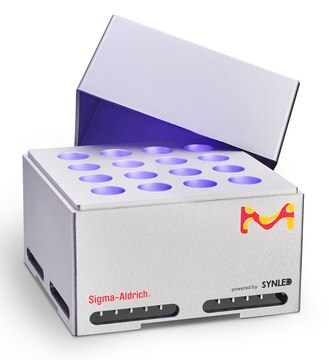MAK086
Acetate Colorimetric Assay Kit
sufficient for 100 colorimetric tests
Sign Into View Organizational & Contract Pricing
All Photos(3)
About This Item
UNSPSC Code:
12161503
NACRES:
NA.84
Recommended Products
usage
sufficient for 100 colorimetric tests
detection method
colorimetric
storage temp.
−20°C
General description
Acetate, the ionized form of acetic acid, is a critical metabolite in fatty acid and carbohydrate metabolism. The majority of acetate is utilized as the conjugate to coenzyme A (CoA), acetyl-CoA. Acetyl-CoA is a precursor to fatty acid and cholesterol synthesis and an important starting compound for the citric acid cycle. Acetyl-CoA also serves as a precursor for the synthesis of acetylcholine and as the donor for acetyl groups for post-translational acetylation reactions of histone and non-histone proteins. Acetate is generated from the metabolism of carbohydrates, amino acids, fatty acids, and ethanol.
The Acetate Assay kit provides a simple and direct procedure for measuring acetate in a variety of samples. Acetate concentration is determined by a coupled enzyme assay, which results in a colorimetric (450 nm) product proportional to the acetate present.
The Acetate Assay kit provides a simple and direct procedure for measuring acetate in a variety of samples. Acetate concentration is determined by a coupled enzyme assay, which results in a colorimetric (450 nm) product proportional to the acetate present.
Application
Acetate colorimetric assay kit has been used to determine acetate concentrations calorimetrically.
Suitability
Suitable for the detection of acetate in serum, plasma, animal tissues (liver, kidney, muscle, heart etc.), cell culture (adherent or suspension cells) and food.
Principle
The Acetate Assay kit provides a simple and direct procedure for measuring acetate in a variety of samples. Acetate concentration is determined by a coupled enzyme assay, which results in a colorimetric (450 nm) product proportional to the acetate present.
replaced by
Product No.
Description
Pricing
Storage Class
10 - Combustible liquids
Choose from one of the most recent versions:
Certificates of Analysis (COA)
Lot/Batch Number
Don't see the Right Version?
If you require a particular version, you can look up a specific certificate by the Lot or Batch number.
Already Own This Product?
Find documentation for the products that you have recently purchased in the Document Library.
Sheng Li et al.
Bioresource technology, 239, 285-293 (2017-05-23)
This study investigated the impact of reverse salt flux (RSF) on microbe community and bio-methane production in a simulated fertilizer driven FO-AnMBR system using KCl, KNO
A refined genome-scale reconstruction of Chlamydomonas metabolism provides a platform for systems-level analyses.
Imam S, et al.
The Plant Journal, 84(6), 1239-1256 (2015)
Acetyl Coenzyme A: A Central Metabolite and Second Messenger
Federico P, et al.
Cell Metabolism, 21(6), 805-821 (2015)
Jeremy D Osko et al.
Biochemistry, 58(36), 3755-3766 (2019-08-23)
Polyamines are small organic cations that are essential for cellular function in all kingdoms of life. Polyamine metabolism is regulated by enzyme-catalyzed acetylation-deacetylation cycles in a fashion similar to the epigenetic regulation of histone function in eukaryotes. Bacterial polyamine deacetylases
Cholesterol Is Synthesized from Acetyl Coenzyme A in Three Stages
Biochemistry (5th Edition) (2002)
Our team of scientists has experience in all areas of research including Life Science, Material Science, Chemical Synthesis, Chromatography, Analytical and many others.
Contact Technical Service








